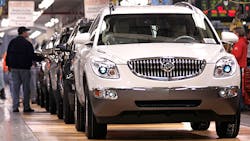As the U.S. car boom begins to wane, American auto giant General Motors is eyeing growth in China as an even more crucial component of its business.
GM auto sales in China through the first eight months of the year jumped 8.1% to 2.38 million, compared with a 4.2% drop to 1.96 million in the U.S. That included 293,537 cars sold in August, a monthly record and up 18% from the year-ago period.
“It has been a surprisingly strong year,” said Matt Tsien, president of GM China. “We were expecting growth in the sort of low-to-middle single digit range compared to last year. So far, this year has been running a little bit stronger than that.”
GM employs 58,000 in China, where it sells sport utility vehicles, as well as cars under its Chevrolet and Buick brands. The latter has a particularly storied history in the country, as the vehicle of choice of Sun Yat-Sen, China’s first president. GM has also targeted China as a venue for its luxury Cadillac line.
GM expects industrywide auto sales in China will reach 30 million by 2020, up from 25.1 million in 2015, Tsien said. Growth is expected due to rising demand in rural parts of China and midsized cities that are poised to take off. GM has targeted middle-income buyers in these regions through joint ventures with SAIC sold under the Baojun and Wuling brands.
In 2014, GM announced plans to invest $12 billion in China over three years. It intends to launch 60 models over the next five years and expects a 65% increase in production capacity in the country.
A key challenge for GM is the rising competitiveness of Chinese companies such as Great Wall, Changan Automobile, BAIC Motor and Dongfeng, which are selling better due to greater confidence in the vehicles’ reliability. These companies have lower labor and material costs than GM.
GM has been forced to increase spending on promotions in China to compete with these brands, said Rebecca Lindland, an analyst at Kelley Blue Book.
The operating margin of GM ventures in China fell to 9.5% in the second quarter from 10.2% a year earlier. That translated into equity income of $471 million down from $503 million.
“The overall market has been very competitive,” Tsien said. “There has been some downward pressure across the entire industry.”
GM’s efforts to counter this trend include launching ten energy-efficient vehicles in China. GM also is eyeing ride-sharing as a potential growth area.
An overarching goal is to keep the crown of biggest foreign automaker in China, a title GM seized from Volkswagen in 2015.
By Luc Olinga
About the Author
Agence France-Presse
Copyright Agence France-Presse, 2002-2025. AFP text, photos, graphics and logos shall not be reproduced, published, broadcast, rewritten for broadcast or publication or redistributed directly or indirectly in any medium. AFP shall not be held liable for any delays, inaccuracies, errors or omissions in any AFP content, or for any actions taken in consequence.
